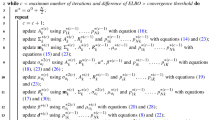Abstract
Shi, Wang, Murray-Smith and Titterington (Biometrics 63:714–723, 2007) proposed a Gaussian process functional regression (GPFR) model to model functional response curves with a set of functional covariates. Two main problems are addressed by their method: modelling nonlinear and nonparametric regression relationship and modelling covariance structure and mean structure simultaneously. The method gives very good results for curve fitting and prediction but side-steps the problem of heterogeneity. In this paper we present a new method for modelling functional data with ‘spatially’ indexed data, i.e., the heterogeneity is dependent on factors such as region and individual patient’s information. For data collected from different sources, we assume that the data corresponding to each curve (or batch) follows a Gaussian process functional regression model as a lower-level model, and introduce an allocation model for the latent indicator variables as a higher-level model. This higher-level model is dependent on the information related to each batch. This method takes advantage of both GPFR and mixture models and therefore improves the accuracy of predictions. The mixture model has also been used for curve clustering, but focusing on the problem of clustering functional relationships between response curve and covariates, i.e. the clustering is based on the surface shape of the functional response against the set of functional covariates. The model is examined on simulated data and real data.
Similar content being viewed by others
References
Cappé, O., Robert, C.P., Rydén, T.: Reversible jump, birth-and-death and more general continuous time Markov chain Monte Carlo samplers. J. Roy. Stat. Soc. Ser. B 65, 679–700 (2003)
Fan, J., Yao, Q., Cai, Z.: Adaptive varying-coefficient linear models. J. Roy. Stat. Soc. Ser. B 65, 57–80 (2003)
Faraway, J.: Regression analysis for a functional response. Technometrics 39, 254–261 (1997)
Faraway, J.: Modelling hand trajectories during reaching motions. Technical report # 383, Department of Statistics, University of Michigan (2001)
Fernandez, C., Green, P.: Modelling spatially correlated data via mixtures: a Bayesian approach. J. Roy. Stat. Soc. Ser. B 64, 805–826 (2002)
Fraley, C., Raftery, A.E.: MCLUST version 3 for R: Normal mixture modeling and model-based clustering. Technical report #504, Department of Statistics, University of Washington (2006)
Gaffney, S., Smyth, P.: Curve clustering with random effects regression mixtures. In: Bishop, C., Frey, B. (eds.) Proc. Ninth Inter. Workshop on Artificial Intelligence and Statistics (2003)
Green, P.J.: Reversible jump MCMC computation and Bayesian model determination. Biometrika 82, 711–732 (1995)
Green, P.J., Richardson, S.: Spatially correlated allocation models for count data. Technical report, University of Bristol (2000)
Hubert, L., Arabie, P.: Comparing partitions. J. Classif. 2, 193–218 (1985)
James, G., Sugar, C.: Clustering for sparsely sampled functional data. J. Am. Stat. Assoc. 98, 397–408 (2003)
Kamnik, R., Bajd, T., Kralj, A.: Functional electrical stimulation and arm supported sit-to-stand transfer after paraplegia: a study of kinetic parameters. Artif. Organs 23, 413–417 (1999)
Kamnik, R., Shi, J.Q., Murray-Smith, R., Bajd, T.: Nonlinear modelling of FES-supported standing up in paraplegia for selection of feedback sensors. IEEE Trans. Neural Syst. Rehabil. Eng. 13, 40–52 (2005)
Kennedy, M.C., O’Hagan, A.: Bayesian calibration of computer models (with discussion). J. Roy. Stat. Soc. Ser. B 63, 425–464 (2001)
Louis, T.A.: Finding the observed information matrix when using the EM algorithm. J. Roy. Stat. Soc. Ser. B 44, 226–233 (1982)
MacKay, D.J.C.: Introduction to Gaussian processes. Technical report, Cambridge University; available from http://wol.ra.phy.cam.ac.uk/mackay/GP/ (1999)
McLachlan, G.J., Peel, D.: Finite Mixture Models. Wiley, New York (2000)
Müller, H.G.: Functional modelling and classification of longitudinal data. Scand. J. Stat. 32, 223–240 (2005)
Ramsay, J.O., Silverman, B.W.: Functional Data Analysis. Springer, New York (1997)
Rand, W.M.: Objective criteria for the evaluation of clustering methods. J. Am. Stat. Assoc. 66, 846–850 (1971)
Rice, J.A., Silverman, B.W.: Estimating the mean and covariance nonparametrically when the data are curves. J. Roy. Stat. Soc. Ser. B 53, 233–243 (1991)
Schwarz, G.: Estimating the dimension of a model. Ann. Stat. 6, 461–464 (1978)
Shi, J.Q., Murray-Smith, R., Titterington, D.M.: Bayesian regression and classification using mixtures of Gaussian process. Int. J. Adapt. Control Signal Process. 17, 149–161 (2003)
Shi, J.Q., Murray-Smith, R., Titterington, D.M.: Hierarchical Gaussian process mixtures for regression. Stat. Comput. 15, 31–41 (2005)
Shi, J.Q., Wang, B., Murray-Smith, R., Titterington, D.M.: Gaussian process functional regression modeling for batch data. Biometrics 63, 714–723 (2007)
Stephens, M.: Bayesian analysis of mixture models with an unknown number of components–an alternative to reversible jump methods. Ann. Stat., 40–74 (2000)
Titterington, D.M., Smith, A.F.M., Makov, U.E.: Statistical Analysis of Finite Mixture Distributions. Wiley, New York (1985)
Author information
Authors and Affiliations
Corresponding author
Rights and permissions
About this article
Cite this article
Shi, J.Q., Wang, B. Curve prediction and clustering with mixtures of Gaussian process functional regression models. Stat Comput 18, 267–283 (2008). https://doi.org/10.1007/s11222-008-9055-1
Received:
Accepted:
Published:
Issue Date:
DOI: https://doi.org/10.1007/s11222-008-9055-1




